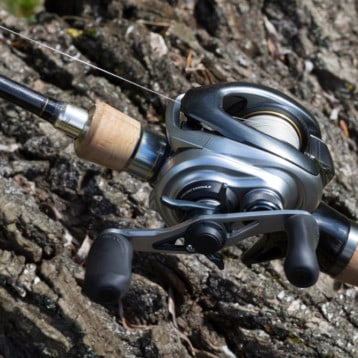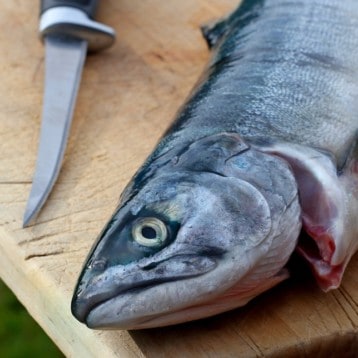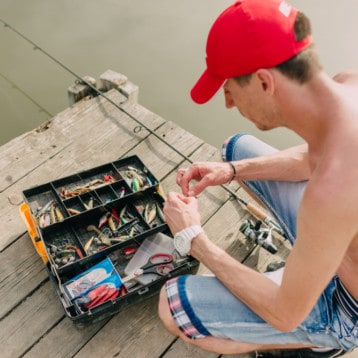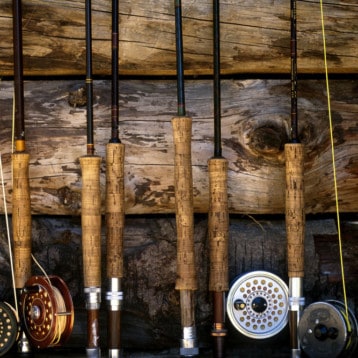The best fishing & hunting tends to happen in conditions that would be considered less than ideal. Cold beer and a hot sun are a great combination, but it’s usually dark, raining, and there’s a cold wind that’s colder than the beer biting at you. That’s why having the best waders is so important. It’s one of the easiest ways to stay warm, stay fairly dry, and be able to catch your quota.
Table of Contents
Here Is the Best Chart for Waders
In some ways, the best waders can only be found by trying them on. You’ve got to know how they fit, how they move, and if the storage built into them is easy enough to access. This chart will help you find the waders to try.
Salty Dog’s Favorite Waders
Caddis Men’s Tauped Deluxe Breathable Stocking Foot Wader


What is nice about these waders and why they’re the best foot waders is the fact that they are reinforced in just the right places. With double knees and breathable gravel guards, these waders work great in virtually any weather condition and will help to keep you warm. It’s made with a polyester outer and proprietary technology on the inside that helps to wick away sweat without letting the water come in to make you clammy. The feet are glued, stitched, and double taped to help keep the moisture away from your legs and feet as well.
Toggs Amphib Neoprene Boot Foot Wader


For those extra cold days, the best waders are going to be insulated perfectly so that you still stay warm. That’s what is nice about these food waders. Not only do that have 200gr Thinsulate insulation built into them, but there’s a 3.5mm layer of neoprene included as well. The kneepads are reinforced and the chest pocket is lined with fleece in case your hands are getting cold. The high bib design provides an extra layer of protection and the cleated outsoles are a nice final touch.
Redington Crosswater Fishing Wader


Although these waders sit a little low on the body, there are still some great things about them that make them one of the best waders available right now. The top feature is the 3 layers of DWR coated fabric that are virtually guaranteed to help keep you dry. There are integrated gravel guards with a hook and the flip out pocket is definitely useful. There are belt loops built into the waders as well and a wading belt comes with the waders out of the box. The opposing buckle system can help make these waist high waders if that is your preference. They definitely work!
Caddis Men’s Green Neoprene Stocking Foot Wader


The stocking foot design is a little more flexible, which makes these neoprene waders from Caddis Wading Systems one of the best fishing waders available today. With double stitching, tape, and glue, there is a size that works with virtually every body type and size in this line of waders. These are high chest waders, so not everyone is going to like them, because they fit more like a pair of coveralls. Overall, however, they are extremely comfortable, have sliding gravel guards, and the hand warmer pocket is actually big enough to fit your hands into it without difficulty. These are great waders at a great price.
Allen Company Brule River Chest Wader


If you’re looking for a basic set of waders that will help to keep you nice and dry and are on a budget, then these might just be the best waders for you. They’re made from a nylon fabric and have a PVC laminate that helps to give a little extra-added protection. The wading boots are built into the waders, as are the suspenders. A draw cord around the top helps to keep everything snug and tight. They’re not fancy, but they work and it’s difficult to argue with that.
How To Find the Best Waders?
The reviews that you find here are going to help you find some great waders, but the best fishing waders are the ones that work with you. Above anything else, your new waders must be breathable. If they are not, you’ll get wetter from the cold sweats that are going on then from the water trying to get into the waders. Think about getting waders that have materials, which are similar to Gore-Tex for the best experience.
You’ve also got to choose from boot foot waders or stocking foot waders. Some of this comes down to personal preference, of course, but the stocking foot waders tend to be a little more versatile. You typically have a little more movement and flexibility with them.
The best waders should be as light as possible. The best wader reviews might talk about how dry some waders keep you, but if they weight a few dozen pounds, you’ll find yourself fatigued faster than needed and that can make for a premature end to a day of fishing.
The best waders will help you do more than just enjoy a gray day at a mountain stream. Duck hunting generally needs to have waders on the equipment list as well. The best waders for duck hunting are typically chest waders because they give you enough flexibility and comfort for long moments of stillness in the habitat. They will also have storage placement in the chest area for your calls or other gear so they don’t have to get wet.
The best waders can also help in other tasks. Farmers might use waders to stay clean and dry on a wet day in the fields. Others might use waders for clamming. As long as they are comfortable, flexible, and breathable, they’ve passed the first test.
Then there’s the price to consider: the best waders are typically about $100, give or take a little on either side.
When it comes to outdoor gear, people often quote author Alfred Wainwright as he very famously said, ‘There is no such thing as bad weather, just unsuitable clothing.’ And hardcore hunters would agree if one said the best hunting happens when the weather is at its absolute worst thus, there is no choice but to wear the appropriate gear.
When it comes to selecting the right wader, here is a comprehensive guide that will help you.
Boot, Waist, & Chest Waders
Here are some of the different types of waders available on the market these days:
Hip Boots
Hip waders essentially are meant to be used in shallow and slow-moving waters such as sedate rivers, small streams, etc. You should only count on hip waders to be useful if the water is beneath knee length and doesn’t have a heavy current.
They extend from the foot up to the upper leg of the wearer; some of them have boots attached, whereas others don’t. These are considered to be incredibly comfortable as they are easy to wear and take off. Plus, hip waders tend to be pretty lightweight, which makes them ideal for packing and convenient for warmer weather.
Waist Waders
Waist waders obtain the middle ground and fall between the chest and hip waders. They tend to have a loose fit which gives them the appearance of rain pants; however, they are held upward with the aid of a hip belt. Waist waders are meant to be worn in medium-depth waters that come up to your thigh.
Waist waders are the perfect option for both the summer and winter months. If you plan on fishing in cold mountain streams, then opt for waist waders as they provide enough coverage to get you through prolonged exposure to freezing weather. However, given that the upper is exposed, it can also be worn during the summers.
Chest Waders
Perhaps the most popular and versatile type of wader is the chest wader. It offers the maximum amount of coverage one can get without having too restrictive of a fit. Chest waders prepare for angles for all kinds of fishing scenarios, even ones involving heavy current or stubborn fish.
They can be worn in windy, rainy, and cold weather, inside and outside water. They are perfect for winters. Chest waders should be worn with a wading belt to avoid flooding.
Stockingfoot & Boot Waders
Stockingfoot Waders
These are one of the most sought-out waders as they offer a wide range of selection and are easily available. They do not come with wading boots, which can be quite a tedious task. They can be worn without wading boots, in which case they are much lighter, making them perfect for backpacking into fishing holes or traveling. Stockingfoot waders offer a wide collection when it comes to tracking underfoot.
Bootfoot Waders
The best part about these waders is that they have boots built into them, which saves you from making an additional purchase. They are best for fishing on a beach as they prevent the sand and dirt from getting into your gear due to their mess-free design.
Bootfoot waders are efficient and easy to wear, given how easily they can be worn and taken off. Plus, they offer warmth which is why they can be worn in cold temperatures. However, some drawbacks of such waders are that they cannot be customized to fit every person since they don’t have laces and they tend to be heavyweight; thus, they can be troublesome to carry.
Wader Features
Here are some of the most important considerations you need to make when it comes to buying the right waders.
Insulated/Uninsulated
Whether or not you should opt for insulated waders depends upon the climate you plan to hunt in. The greater insulation they have, the more they will protect you against cold and keep you warm. Waders may also come with padding, which serves the purpose of protecting your knees from mechanical injury and provide warmth. If the cold temperature isn’t a concern, you can opt for a more breathable and uninsulated option.
Durability
When buying waders, it is important to consider how much time you will spend hunting or fishing. If you are a hardcore hunter who spends hours possibly hunting all day, then it’s important for you to invest in good-quality waders that can keep up with your style. Look for a wader that is resilient to scuffs and nicks and is made from a durable material, which usually is heavy and warm, so it can last you all year no matter how much time you spend submerged in water.
Seams
It is crucial to pay attention to the seams of the waders. Good-quality waders should be welded from the seams and double taped after they are stitched to prevent any leakages. Over time, the seams on the waders can become quite troublesome if not sealed well.
Camo
The pattern on the wader can be pretty useful, depending upon what kind of hunting you plan to do. For duck hunting, they can be quite useful; however, as far as fishing is concerned, they don’t make much of a difference.
They allow you to be less noticeable out there. Plus, waders can come in various patterns of camo, which you can choose from, depending upon the nature of the area.
Best Brands
Some great brands that offer excellent quality and durable waders are USiA, Cabela’s, LaCrosse, Simms, Patagonia, Fishwest, Front Range Angler, etc.
Size
How fit you are, and the size of the wader are of utmost importance. It is essential to choose the right fit so the wader can be comfortable and keep you dry. Start with the boot and see how that fits you, and then pay attention to the rest of the fit. It is important to realize that the sizing will not be the same across all brands; thus, make sure you check the size chart and choose the size which works best for you.
The ideal scenario would be to try the wader at a local shop and then buy it as ordering online could potentially end in you buying the wrong size. If the wader is too small, the seams might become too stressed, causing discomfort and leaks.
How to Store and Maintain the Waders?
As far as storage is concerned, waders should never be stored after being folded; they should always be hanged. As far as the maintenance is concerned, after a certain amount of time, no matter how good the quality of the wader is, they might need some repairs. One of the most common issues that arise is leakage, which may lead to water, moisture, and dirt seeping in, leading to your legs freezing.
If this happens, the first thing to do is let them dry completely inside out. Next, you need to detect the leak or puncture. For that, take rubbing alcohol and sprinkle it over the wader, and the leaks or punctures should become visible. After you’ve identified the puncture, take polyurethane glue and apply it to the punctured and damaged area. Let it dry for 12 hours at least, and your waders are good to be worn. However, note that this method would work only for neoprene and breathable waders.
For rubber waders, if there is a puncture or leakage, clean the area first. Then, treat it with sandpaper and put rubber cement on the affected patch. You need to let the first layer of the rubber cement dry before putting on a second one. Let the wader dry for 8 to 10 hours, and it will be good to go.
Washing and Drying
There is a technique to wash your waders. First of all, check if it’s necessary to wash them; you should usually wash your waders about 3-5 times a season before winter. A fat-burning coating usually starts to clog the membrane capillaries, which needs to be gently removed using shampoo. Most wader manufacturers offer their special shampoo to clean the model; however, regular hair shampoo will also work.
Do not use scouring pads or hard brushes as they would damage the wader; instead, opt for a foam sponge, and you should be able to clean it well. Accuracy is required for cleaning the internal surface, and be sure not to be harsh, or else you’ll harm the membrane.
It is crucial to dry the waders thoroughly after coming back from fishing or hunting to prolong their life. You can either hang them or spread them on the grass. It is best to dry them as quickly as you. For this, you can also opt for boot and wader dryers which will help remove all excess water and moisture in a short time. If you place them in the sun or in a windy place, the outer layer should dry soon enough, after which you need to turn them inside out so they can dry thoroughly.
Wader Functionalities
There are certain additional accessories and features that you can look for in a wader. These aren’t necessary by any means, but they will help you make the most of your wader, so they are nice to have.
Gaiters/Gravel Guards
These fold over the wading boots to sit around the cuffs so they can prevent debris, water, dirt, and other foreign elements from entering your gear.
Pockets
Pockets are nice to have as they can aid in keeping your hands warm if you’re in cold temperatures and give you a place to store your things.
Convertible
If you want a single pair of waders that offer versatility, opt for ones that can be converted from chest waders into waist length, so they can be worn in warmer weather.
Materials
The material of the wader should be chosen carefully according to the environment you’ll be fishing in, and the time you will spend in and out of water. Here are some of the most commonly used materials for designing waders.
Rubber
Most waders use rubber along with other materials. In fact, it would be quite rare to come across a chest wader that is completely made from rubber. Rubber waders tend to be waterproof as they usually have PCV in their construction. Adding other fabrics alongside rubber in the wader allows greater movement and comfort for the angler.
Rubber waders tend to be incredibly resilient and tough as they can withstand tears, scratches, and punctures; thus, they make for a good option for tough and harsh situations.
PVC
PVC waders are excellent if you plan on going in the water and spending some time there because they tend to be 100% waterproof. They also are highly durable and, fortunately, one of the least expensive options you can get your hands on. PVC wades are a popular choice for anglers for the warmer months as they offer greater mobility.
Neoprene
Neoprene is a non-breathable material that is warm and thus offers excellent insulation. Therefore, neoprene waders are perfect for wearing in cold temperatures or during colder months. They are available in different levels of neoprene thickness from 3mm to 5mm, where the thicker the material, the warmer it’ll be. Since they are not breathable, they cannot be worn during a warm climate, and they will get too warm to wear. Plus, they will trap condensation, which is the last thing you would want.
Nylon
Nylon waders tend to be lightweight and more breathable than neoprene waders. They don’t offer any insulation, but they do have a waterproof membrane. Since they are breathable and keep moisture and perspiration out to maintain comfort and dryness inside the gear, they can be the perfect choice for warmer months.
Unfortunately, nylon waders have a disadvantage; they are highly prone to scratches, tears, and punctures in high-pressure areas like the knees and the seat. Some waders help this situation by adding padding to such areas to prevent tears and mechanical injury.
Summary
The best waders should be comfortable, but flexible, and be breathable. By using the reviews here and taking these tips into consideration, you’ll be enjoying the best waders for fishing, duck hunting, or your preferred need today.




